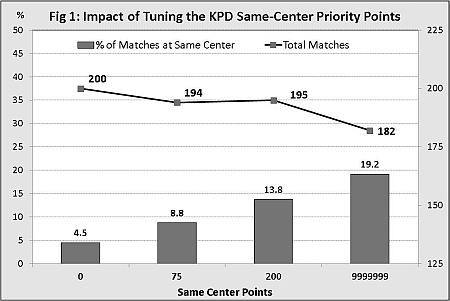Tuning the OPTN's KPD Optimization Algorithm To Incentivize Centers To Enter Their "Easy-to-Match" Pairs
UNOS
Carnegie Mellon Univ
Johns Hopkins Univ &
USNA
Yale Medical Ctr
Northwestern
Univ of Florida
Meeting: 2013 American Transplant Congress
Abstract number: 482
Background: Currently, priority points are awarded in the OPTN Kidney Paired Donation Pilot Program's (KPDPP) optimization algorithm as follows: zero mismatch (200 pts), highly sensitized (125), etc. Increasing the priority (currently 75 pts) for matches in which the donor and matched candidate are at the same transplant hospital is being considered to incentivize programs to enter "easy-to-match" pairs, including those that programs could match themselves.
Methods: 15 historical match runs from May 2011-May 2012 were reoptimized, varying the same-center points from 0, 75, 200, and 9999999 (chosen to ensure the algorithm's selection of same-center matches).
Results: As the same-center points were increased, the total number of matches decreased 9% from 200 to 182. However, the number of same-center matches increased 4-fold, from 4.5% to 19.2% of matches (fig 1). The vast majority of this increase came from same-center matches within non-directed donor chains.

The impact by candidate blood group was small: ABO=O candidates represented 46.6% of matches with same-center pts at 75, and 47.8% using 9999999. The proportion of matches by candidate CPRA changed little, except for those with CPRA≥96, which decreased from 14.5% to 11%. During this time, no centers entered pairs that they could have matched themselves.
Conclusions: Increasing the likelihood that a set of same-center pairs will match at that center is one way to incentivize increased participation in KPD. Chains that include same-center links may be preferred due to decreased likelihood of falling apart and lower ischemic times. Though increasing the same-center points reduced the overall number of matches in this study, in reality increasing the priority for same-center matches incentivizes centers to reveal more of their pairs, which in turn has the potential to increase the number of overall matches.
To cite this abstract in AMA style:
Stewart D, Leishman R, Sleeman E, Monstello C, Lunsford G, Maghirang J, Sandholm T, Gentry S, Formica R, Friedewald J, Andreoni K. Tuning the OPTN's KPD Optimization Algorithm To Incentivize Centers To Enter Their "Easy-to-Match" Pairs [abstract]. Am J Transplant. 2013; 13 (suppl 5). https://atcmeetingabstracts.com/abstract/tuning-the-optns-kpd-optimization-algorithm-to-incentivize-centers-to-enter-their-easy-to-match-pairs/. Accessed December 23, 2025.« Back to 2013 American Transplant Congress
